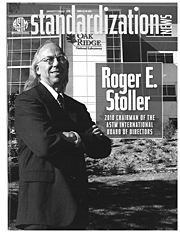 |
Number 118, January-February, 2010 |
 Spin excitations
Spin excitations
SNS, HFIR research bolsters theories of high-temperature superconductors
|
|
Above: A simulation of spin excitations. |
It has long been suspected that the mechanism behind high-temperature superconductivity—the phenomenon that enables electricity to flow with almost no resistance at very low temperatures—is related to a material’s magnetic properties and is the same in both copper-based high-temperature superconductors and the newly discovered iron-based superconductors. Now there’s experimental evidence to back this hypothesis.
The evidence comes in the form of a study published in Nature Physics. The study was performed at the Spallation Neutron Source and the ISIS Facility at the United Kingdom’s Rutherford Appleton Laboratory supplemented by experiments at ORNL’s High Flux Isotope Reactor.
High-temperature superconducting materials, in which a material conducts electricity without resistance at a relatively high temperature, have potential for application to energy-efficient technologies where little electricity is lost in transmission.
This is experimentally the best indication of what the spin excitations are doing. |
The research community was stirred in 2008 when a Japanese team reported high-temperature superconductivity in an iron-based material. Previously, only copper-based, or cuprate, materials were known to have those properties. The discovery elicited widespread and intense analysis of the material’s structure and properties.
“The pairing up of electrons is essential for the formation of the macroscopic quantum state giving rise to superconductivity,” says lead researcher Mark Lumsden of the Neutron Scattering Sciences Division. “One of the leading proposals for the pairing mechanism in the iron-based superconductors is that magnetic interactions provide the glue that binds the electrons together.”
Detailed studies of the magnetic excitations of materials are essential for understanding high-temperature superconductivity. Although superconductivity near absolute zero is common, only certain materials exhibit the property at “high” (i.e., the temperature of liquid nitrogen) temperatures.
The ORNL researchers subjected single crystals of an iron, tellurium and selenium material to neutron scattering analysis at the SNS, HFIR and ISIS.
“Even in comparison to cuprates, this is experimentally the best indication of what the spin excitations are doing. One of the prominent views is that spin excitations are a key ingredient of superconductivity. The first step in evaluating this proposal is understanding what the spin excitations are and what they are doing,” Mark says.
Neutron scattering analysis is considered to be among the most powerful techniques used to understand the molecular structure and interactions in advanced materials. The newly available pulsed-neutron source intensity at the accelerator-based SNS, combined with steady-state neutron beams from the recently upgraded HFIR, give researchers at Oak Ridge valuable new tools for understanding these properties.
“Neutron scattering is the only way to study the full wave vector and energy dependence of the spin excitations that are believed to be behind these superconducting properties,” says co-author Andrew Christianson, who with Lumsden is a member of the Neutron Scattering Science Division.—B.C. ![]()
 Nell-1 patent licensed
Nell-1 patent licensed
Step on long journey to promising treatment
|
Happy outcome: Lab Director Thom Mason and NellOne Therapeutics CEO Tracy Warren (front row) sign the licensing agreement, observed by (back row, from left) Battelle’s Ron Townsend, Partnerships’ Jennifer Caldwell, researcher Bem Culiat, ORO Manager Gerald Boyd, and Partnerships Director Tom Ballard. |
In a major step toward commercialization of a promising therapeutic treatment, UT-Battelle has exclusively licensed patents on inventions based on the Nell-1 gene to NellOne Therapeutics, Inc., a company spun out of ORNL research.
The protein therapy treatment under development takes advantage of the Nell-1 gene’s cell-signaling pathway that controls tissue growth and maturation in mammalian organs.
The foundation for the therapy is research performed by Bem Culiat, who as an ORNL systems genetics researcher identified the role that the Nell-1 pathway plays in tissue growth and maturation.
Bem is leading the NellOne research effort to translate the Nell-1 pathway discoveries into a therapy that restores both mass and function to damaged human tissues, such as heart and skeletal muscle.
If successful, the protein therapy could improve the lives of victims of heart attacks and severe muscle wounds. Other therapies, such as stem-cell treatments, have succeeded in triggering tissue formation but fall short in restoring the actual function of the tissue.
Battelle Ventures, with its Knoxville-based affiliate fund, Innovation Valley Partners, created NellOne with a $1.5-million seed investment in 2008.
“Our executing this license is confirmation from NellOne that sufficient proof-of-principle experiments have been completed and that the company is progressing toward the commercialization of an extremely promising technology that could one day vastly improve the lives of countless heart patients,” says Tracy Warren, NellOne chief executive officer and Battelle Ventures general partner.
“NellOne is currently dedicated to the development of intellectual property and moving into a clinical setting,” Warren continued, noting that it operates out of the IVP office in Knoxville. “A medical treatment based on the patented technologies is years away, making Battelle Ventures’ support even more critical.”
“This licensing agreement is a statement not only of NellOne’s promise but also of how vital the support of venture capital investment is during these crucial early years of technology development and nurturing,” says ORNL Partnerships Director Tom Ballard. “This announcement is an important step along the way to the marketplace past the initial proof-of-concept stage.”
Battelle Ventures and IVP have a combined $255 million—$220 million and $35 million,respectively—to create and accelerate early-stage technologies, including in the East Tennessee region.—B.C. ![]()
 Stephen Nagler, Steven Zinkle elected AAAS fellows
Stephen Nagler, Steven Zinkle elected AAAS fellows
|
Nagler |
Two ORNL researchers have been elected fellows of the American Association for the Advancement of Science.
Stephen E. Nagler is cited by the society “for outstanding contributions to the study of condensed matter, especially pioneering applications of inelastic neutron scattering to low dimensional quantum materials.”
Stephen, a UT-Battelle corporate fellow, is internationally known as a leader in the investigation of magnetic excitations and quantum critical behavior in materials.
Stephen is a fellow of the American Physical Society. He was named ORNL Scientist of the Year in 1998 and, most recently, in 2009 was a member of a team that received an ORNL UT-Battelle Director’s Award for outstanding research on novel iron-based high- temperature superconducting materials. He serves on numerous national and international committees and is a member of the editorial board of Physical Review Letters.
Stephen and his wife, Rosalie, have a son and daughter. They reside in Knoxville.
|
Zinkle |
Steven J. Zinkle is cited by the society “for outstanding fundamental research on metals and ceramics for fusion and fission energy systems, particularly ionizing and collisional radiation effects mechanisms.”
Steven, a UT-Battelle Corporate Fellow and director of ORNL’s Materials Science &Technology Division, joined ORNL in 1985 as a Wigner fellow. He earned bachelor’s and master’s degrees and a doctorate in nuclear engineering, as well as a master’s degree in materials science, from the University of Wisconsin. He became leader of the Laboratory’s Nuclear Materials & Science Technology group in 2001. He was named director of the Materials Science & Technology Division in 2006.
The Wauzeka, Wisc., native is the author or coauthor of more than 200 peer-reviewed publications and currently serves on several national and international committees, including the DOE Fusion Energy Sciences Advisory Committee. He is a fellow of the American Ceramic Society, ASM International, and the American Nuclear Society, and is a 2007 recipient of DOE’s prestigious E. O. Lawrence Award.
He and his wife, Teresa, reside in Knoxville. They have two sons.
Several joint ORNL and University of Tennessee researchers were also announced as AAAS fellows, including UT-ORNL Distinguished Scientist Elbio Dagotto and the Physics Division’s Witold Nazarewicz. ![]()
 Gilna leads BioEnergy Center
Gilna leads BioEnergy Center
 |
Gilna |
Paul Gilna has been named director of the BioEnergy Science Center. Paul will lead research toward the more cost-effective transformation of biomass products into biofuels.
BESC includes 19 research partners from other national laboratories, universities and private corporations. The center is housed in the state-funded Joint Institute for Biological Sciences.
Paul comes to ORNL from the California Institute for Telecommunications and Information Technology and the Center for Research in Biological Systems, both located at the University of California, San Diego. Previously, Paul was director of the Joint Genome Institute at Los Alamos National Laboratory. His research interests range from molecular biology to microbiology to computational biology, and in particular, working at the interface between computation and biology to further enable these disciplines. ![]()
 Four elected physical society fellows
Four elected physical society fellows
|
Gross |
Four ORNL scientists have been named fellows of the American Physical Society. The APS recognized Carl Gross, Dan Shapira, Matthew Chisholm and Rajesh Maingi for their work in a range of physics-related disciplines. Fewer than one half of one percent of APS members are elected to become fellows.
Carl Gross, a researcher in ORNL’s Physics Division, was cited for enabling the studies of most exotic atomic nuclei through the invention and implementation of novel experimental methods.
|
Shapira |
Dan Shapira was cited for contributions to the study of nuclear collisions: the discovery of nuclear orbiting, pioneering measurements of the space-time extent of particle-emitting sources, and seminal studies of fusion with
n-rich exotic beams, and for development of innovative instrumentation to enable these studies.
|
Chisholm |
Matthew Chisholm, a researcher in the Materials Science & Technology Division, was cited by the APS’s Division of Materials Physics for pioneering contributions to materials and interface physics through scanning transmission electron microscopy.
|
Maingi |
His research has concentrated on the atomic and electronic structure of defects and interfaces in materials. He has been instrumental in the co-development of a new imaging technique that can directly reveal individual atoms.
Rajesh Maingi, who is on a long-term assignment at Princeton Plasma Physics Laboratory, was cited for physics research and demonstration of plasma density control in fusion devices, and for the discovery of a new class of instabilities in plasmas. ![]()
 |
 Leaf as energy research opportunity
Leaf as energy research opportunity
ORNL is partnering with Nissan and TVA in the development of 2,500 charging stations in Tennessee to support a new electric car. Lab Director Thom Mason says ORNL will be heavily involved with enhancing the infrastructure for Nissan’s Leaf electric vehicle.
“We’re going to host some of the solar-assisted charging stations, so we’ll be real participants in the sense of providing opportunities to our employees and also for some of our fleet vehicles to recharge,” Tom said January 15 during a Nissan-sponsored event at Knoxville’s World’s Fair Park to introduce the electric vehicle. “We’re also very interested in understanding better how all of this is going to work as the deployment of electric vehicles ramps up.”
 |
Nissan’s Leaf |
Nissan plans to build 4,700 electric vehicles that will be supported by 11,000 charging stations nationwide. ORNL will focus on helping in the effort to create the most energy-efficient charging stations possible.
“There’s going to be a lot of data in terms of consumer behavior—when do people plug in, when do they need to charge and how does that interact with the grid and the generating capacity,” Tom says. “There’s a real win here in learning how people charge their cars without adding to the peak load, and that depends on a lot of real-world usage. That’s what we’re going to learn about.”—Fred Strohl
 Meitner’s memory preserved
Meitner’s memory preserved
|
HZB’s Anke Kaysser-Pyzalla (right) with Associate Lab Director for Neutron Sciences Ian Anderson. |
One special guest at January’s VULCAN workshop at the Spallation Neutron Source described her facility’s one-two punch for materials research. Anke Kaysser-Pyzalla is scientific director and chief executive of Germany’s Helmholtz Zentrum Berlin fur Materialien und Energie GmbH, which was formed about a year ago by combining the Hahn-Meitner Institute and BESSY.
As a single institution, HZB now offers a research reactor, the BER-II, and BESSY, one of Europe’s top light sources. HZB has a staff of 1,000, who work with 2,500 users, including the upgraded reactor.
“We are also interested in collaboration using a spallation source as a complement to what we can do with the BER reactor, and those are experiments where you need to look at the dynamics of processes,” says Pyzalla.
HZB focuses on neutron scattering in extreme environments, such as low temperatures and high magnetic fields, and is also focusing on development of solar-energy-related materials. The SNS’s VULCAN, an engineering diffractometer led by Xun-Li Wang, will specialize in materials deformation and residual stress studies.
“VULCAN is a very interesting instrument because it allows us to perform studies on systems that couldn’t be done before,” Pyzalla says, adding that the Helmholtz Center’s syncrotron source operation in the UV-to-low-energy range “is definitely unique and complimentary to what you can do with neutrons.”
|
Lise Meitner |
On a historical note, Pyzalla says HZB in the wake of the dissolution of the Hahn-Meitner Institute has taken steps to preserve the legacy of Lise Meitner, who is now credited as a key discoverer of nuclear fission before having to flee her native country in World
War II.
Those steps include naming the HZB campus the Lisa Meitner Campus and a main thoroughfare the “Hahn-Meitner Platz,” in addition to a planned colloquium and fellowship named for Meitner.
“From all discussions, she was a very lovely person, but she had a very hard destiny,” Pyzalla says.
 Smoke signal
Smoke signal
ORNL is instituting a new smoking policy that restricts where one may smoke. Considering that not many years ago people typically smoked in their offices, it’s a sign of how quickly society can change.
The designated smoking areas will be located at least 25 feet from building entrances and ventilation ducts and will be equipped with cigarette butt receptacles. Smoking will not be allowed between designated smoking areas.
The new rules come as a response to health studies that indicate that even second-hand smoke is harmful.
A number of Lab employees have voiced their support for the new rules, while a few smokers have correspondingly been disappointed by the new restrictions.
One smoker may have had the best response, however. When told of the new rules, he said, “This may be the thing that finally gets me to quit.”
 Transition, 21st Century-style
Transition, 21st Century-style
For ORNL staff members, this is the last issue of ORNL Reporter they will receive printed on paper. Reporter is shifting to an on-line
format.
Many of the details are to be determined, but we’ll still provide news on science in the niches of the Lab, as well as news about people and
operations.
The reasons for the shift are more related to the way news travels nowadays than to saving trees, although several readers have questioned why we still printed on paper in an electronic age.
One reason is our retiree readership, which is about half Reporter’s circulation. It’s a readership that we value. For our retirees, a new Reporter more geared to them will continue to appear in their mailboxes.
Thanks for reading Reporter. We hope you look forward to the new approach.
Reported by Bill Cabage |
 ORNL simulations explain unexpected DNA-nanotube flow
ORNL simulations explain unexpected DNA-nanotube flow
Researchers working toward a low-cost DNA sequencing tool for medical diagnostics and other uses have proposed a microfluidic device that uses a single-walled carbon nanotube as a nanopore conduit to thread, or translocate, a single strand of DNA from one reservoir with electrolyte to another, analyzing and sequencing the DNA in the process.
The Arizona State and Columbia University team turned to the Physics Division’s Predrag Krstic to explain unexpected results when they measured the translocation current of material through the nanotube.
|
This visualization depicts the flow of ions and DNA through a single-walled carbon nanotube. Instruments based on the concept could one day be a common fixture in doctors’ offices. |
In such a device, the negatively charged DNA material, which is immersed in an electrolytic fluid, is propelled, so to speak, through the nanotube by an electric field. When the Arizona State team measured the current flowing through the nanotube, they were baffled by the data.
“They were surprised by the current of electrolytic ions that was orders of magnitude higher than any prediction,” Predrag says. “That’s where we came into the project.”
Predrag and former ORNL researcher Sony Joseph performed atomistic molecular and fluid dynamics simulations at the University of Tennessee’s National Institute for Computational Sciences, located at ORNL.
A National Institutes of Health initiative toward a “$1,000 sequencer” is driving the development of these types of microfluidic technologies, which would allow doctors to quickly analyze segments of DNA for traits that could be precursors, or causes, of disease. Such a doctor’s office instrument would be an invaluable tool for diagnosing and treating genetically based conditions.
Krstic and Joseph, in a paper published with their ASU and Columbia collaborators in the Jan. 1, 2010, issue of Science, attributed the mysterious current surge to the “slipping” of water molecules through the perfect and hydrophobic inner surface of the carbon nanotube and to trapped electrical charge.
Understanding such phenomena is key to the development of these single-molecule-detection instruments that would be inexpensive enough to become common in doctor’s offices.
Predrag notes that almost a decade ago, a similar approach to threading single strands of DNA for high-throughput sensing established groundwork for the nanopore approach. ORNL’s Thomas Thundat and James Lee pioneered and patented nanogap fabrication by electrolytic deposition of metal nanoelectrodes, which would enable sequencing based on reading of transverse electron tunneling current when a DNA strand is shepherded through the nanogap.
The ASU-Columbia approach relies on the single-walled carbon nanotube as the conduit. The concept has received Recovery Act funding through the NIH’s “Grand Opportunities” initiative (the goal of a $1,000 sequencer) for the ASU, Columbia and ORNL effort.
“This is an example of how the front of science is increasingly multidisciplinary, with contributions by experimentalists and theorists in atomic and solid-state physics, chemistry, biology and engineering,” says
Predrag.—B.C. ![]()
 ORNL-UT: Novel receptors key to bacterial behavior
ORNL-UT: Novel receptors key to bacterial behavior
Using a combination of experimental and computational techniques, a team of researchers from ORNL and the University of Tennessee has discovered a novel type of receptors in bacteria that sense changes in oxygen concentration and other redox
parameters.
Their work, which has been published in the online Proceedings of the National Academy of Sciences, may help scientists better understand how sensing of the environment is linked to cell metabolism and to predict behavior of hundreds of bacterial species that have yet to be studied experimentally.
The role of the newly found bacterial receptor solves an important dilemma. |
“Bacteria swim in the environment, which they constantly monitor using an array of receptors. Few of these receptors have been thoroughly studied and the exact role of these and thousands of other receptors in bacteria is not known,” says Igor Jouline, ORNL researcher and joint faculty professor at the University of Tennessee. Igor led the computational part of the project.
The ability to predict what signals bacteria will respond to by changing their swimming direction is very important, Igor says. “In principle, one can then attract bacteria to or repel them from certain environments. Receptors can also be attractive targets for a drug design. One can ‘blind’ bacteria by targeting their receptors, thus making them less competitive,” he says.
“The receptor that we have found in a nitrogen-fixing bacterium Azospirillum was located next to the genes involved in nitrogen fixation,” says Gladys Alexandre, associate professor of biochemistry, molecular and cell biology at the University of Tennessee, who led the project. “Usually, it is a good sign of targets that receptor might regulate.”
Researchers were unsure which parameter—oxygen, light, redox conditions and even voltage—the receptor detected. Researchers in the Computer Science & Mathematics Division used a 3-D structure of a similar domain from an unrelated sensor and hundreds of protein sequences of related receptors from public databases to computationally predict what the receptor might sense.
Their models indicated the receptor is a redox sensor. The receptor detects changes in redox status of the cell, which in turn is affected by oxygen concentration. The computational predictions were verified and confirmed experimentally using genetic, biochemical and microbiological techniques at UT.
Further experiments established that the receptor is specifically turned on when bacterial cells fix atmospheric nitrogen. Nitrogen fixation, which is exclusively carried out by microorganisms, is critical to life, because this is the pathway for nitrogen for the food supply—through plants and animals who receive it from microorganisms.
“The role of the newly found bacterial receptor solves an important dilemma,” Igor says. “On one hand, the key enzyme of nitrogen fixation can be deactivated by oxygen. On the other hand, bacteria do need oxygen for their oxidative metabolism. So, the receptor allows bacteria to detect a specific low oxygen concentration, which provides them enough energy while not damaging the process of nitrogen fixation.”
Azospirillum, bacteria, in which the new receptor was discovered, has a potential to enhance the growth of important plant crops such as wheat, sorghum, rice and corn, as well as grasses that are at the center of bioenergy research, such as switchgrass. They already have been tested as biological, ecologically friendly fertilizers. The new study by the UT-ORNL team thus opens up a new direction in improving strains for future agricultural and bioenergy applications.
The research was funded by the National Science Foundation, National Institutes of Health and ORNL’s BioEnergy Science Center, which is supported by the DOE Office of Science.—B.C., with Igor Jouline ![]()
 Chilled water plant boosts data center energy efficiency
Chilled water plant boosts data center energy efficiency
|
Buildling 5600’s chilled water plant. |
In just five months, what once was a loading dock on the south side of the Engineering Technology Facility, Building 5800, has now been transformed into an energy efficient chilled water plant. Construction of the plant is the reason why White Oak Avenue was closed in October.
A chilled water plant is a closed-loop system that cools water used for air conditioning in heating, ventilating and air-conditioning systems and for other equipment or processes, such as ORNL’s supercomputing duo, Jaguar and Kraken.
The new chilled water plant consists of three 1,500 ton chillers and three cooling towers that provide a cooling capacity of 4,500 tons. This means we could turn 4,500 tons of water into ice in one day if we wanted to.
The new 5800 chilled water plant delivers chilled water to the 6000 area buildings for HVAC systems, process loads and future projects. This allows the old chilled water pipe lines serving the 6000 area buildings to be disconnected from the 4509 chilled water plant, that in turn gives cooling capacity back to Building 4509. As a bonus, it allows the troublesome and environmentally unfriendly transite lines to be taken out of service.
The new plant supports HVAC systems in Buildings 5100, 5200, 5700, and 5800, allowing the Lab to free up capacity at the Building 5600 Central Energy Plant to ultimately allow for dedicated cooling and future expansion of the Computational Sciences Building Data Center.
Building 5800’s new chilled water plant will help realize energy efficiency improvements in data center operations. As the Building 5600 plant will now support the data center exclusively, chilled water temperatures can be elevated, allowing for more efficient chiller operation, less cooling tower water evaporation, fewer chemicals for treating cooling tower water, less tower blowdown, lower pump horsepower, and overall less energy usage.
All of the new chilled water and central energy plants built at ORNL over the last eight years are high-efficiency models that exceed industry standards in energy conservation. They provide a total of 19,250 tons of chilled water. Premium efficiency motors and variable-speed drives are used for part-load operation on select chillers, pumps, and fans for low-speed operation at high efficiencies. Condenser water temperature is maintained as low as is practical to reduce the level of chiller horsepower. Two-way valves and automatic flow control valves are used in conjunction with the variable-primary piping scheme to limit flow, allowing the system to attain a maximum differential temperature and minimum flow. The result is that minimal pump horsepower is required and the maximum chiller capacity can be attained.
From the cooling towers you see on top of the building to the pumps and chillers on the plant floor, the ETF chilled water plant truly is green.—David Bozich ![]()
 ORNL researchers receive ARRA early career grants
ORNL researchers receive ARRA early career grants
|
Bardayan |
Four ORNL researchers are among the 69 scientists that will share up to $85 million in funding for five-year research grants as part of DOE’s new Early Career Research Program.
The program, funded under the American Recovery and Reinvestment Act, is designed to support exceptional researchers during the crucial early career years, when many scientists do their most formative work.
Daniel Bardayan of the Physics Division was selected for “Studies of Nuclear Reactions that Drive Stellar Explosions and Synthesize the Elements,” funded by the Office of Nuclear Physics. Bardayan previously received a Presidential Early Career Award for Science and Technology and is a former Wigner fellow.
Questions as to how the elements were created and what drives stars and stellar explosions can only be answered with measurements of reactions on short-lived, unstable nuclei. Since targets of these short-lived nuclei cannot be fabricated (they decay very quickly) these measurements require accelerator-based experiments with beams of exotic nuclei such as those available at ORNL’s Holifield Radioactive Ion Beam Facility (HRIBF).
The goal of Daniel’s project is to combine exotic beams at the HRIBF with a new high-density supersonic gas-jet target to make direct studies of the astrophysical reactions and nuclei that drive stellar explosions and synthesize the elements.
|
Bingham |
Phillip Bingham of the Measurement Science & Systems Engineering Division was selected for “Research and Development of Detection Systems for Neutron Imaging,” funded by the Office of Basic Energy Sciences.
Phillip’s effort is to develop a high-resolution transmission imaging system that will extend the application of neutron imaging to micro-scale structures, enabling groundbreaking research in areas such as renewable energy, energy storage, efficient transportation, and biofuels.
Current state-of-the-art neutron radiography reaches the 10-15 micrometer resolution range with high-cost detectors; however, typical resolutions are on the order of no better than 50 micrometers. The proposed development will result in an increased resolution in the one-micrometer range using less expensive, lower- resolution detectors through the use of a magnified detection system.
|
Perumalla |
Kalyan Perumalla of the Computational Sciences & Engineering Division was selected for “ReveR-SES: Reversible Software Execution Systems,” funded by the Office of Advanced Scientific Computing Research.
Kalyan’s proposal builds on his unique combination of expertise in reversible software systems and high-end parallel computing. “It is aimed at a paradigm shift in ultra-scale computing, called reversible software execution, which holds new promise in the area of high performance computing,” he says.
His research focuses on the application of novel reversible (anti-) computation methodologies, ultimately aimed at addressing multiple challenges in ultra-scale computing, including energy consumption, performance optimization, fault tolerance and debugging.
|
Safa-Sefat |
Athena Safa-Sefat of the Materials S&T Division was selected for “Origin of Superconductivity in Structurally Layered Materials,” funded by the Office of Basic Energy Sciences.
The goal of Athena’s project is to understand the fundamental mechanisms that produce superconductivity at high temperatures in structurally layered materials.
The work will be focused on materials design and synthesis but will also include significant efforts in theoretical calculations and neutron scattering. Superconducting materials have the potential to impact a variety of energy relevant technologies, including power generation and transmission, particularly if materials can be found that can carry more current and operate at higher temperatures. Ultimately this research could lead to the discovery of new superconductors with superior properties compared with current materials.
The national laboratories’ grants will be at least $500,000. —B.C. ![]()
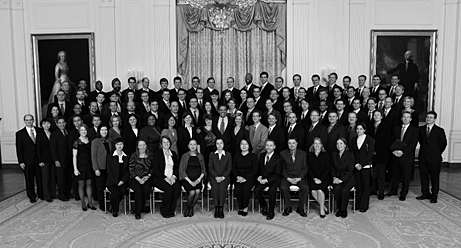 |
President Obama was present on January 13 when Chemical Sciences Division’s Gary Baker picked up his Presidential Early Career Award for Science and Engineering in a White House ceremony. Gary’s award was announced last July. Also receiving a PECASE award under the Department of Veterans Affairs was Melina R. Kibbe of the Jesse Brown VA Medical Center and Northwestern University. Melina is the daughter of ORNL retiree Keith Kibbe, who sent us this photo. |
| The Presidential Early Career Award winners assemble. President Obama is in the center. Gary Baker is second row from top, extreme left. Melina Kibbe is same row, fifth from left. | |
 New Staff Members
New Staff Members
William Joseph Biloski, Environmental Management Program Office
Stacy Lynn Boggs and Thomas Jette Bundy II, Quality Systems and Services
Rebecca Kimberly Bunch, Kevin Lee Wharton and Joseph Wesley Galloway, Nuclear & Radiological Protection
Anne Russell Calhoun (re-hire), Carla Leonard Agreda, Lorri Myers, Chelsea Laree Stewart and Gina Marie Hensley, Human Resources Dir.
Melanie J. Castle and John W. Krueger (transfer), Audit and Oversight Dir.
William Kenneth Cochran and Partha Pratim Mukherjee, Computer Science and Mathematics
Cory R. Croegaert, Global Initiatives Dir.
Greg Andrew Ogle, Robert Jason Newby and Geffrey Arthur Ivey, Global Nuclear Security Technology
Mohammed Mohsen Olama and Stacy Jackson Prowell, Comp. Sci. & Engrg.
Barbara Penland, Communications & External Relations Dir.
Duminda I. B. Randeniya, Paul Henri Chambon, Aleksandar Dragan Dimitrovski, Bo Shen and Bradley D. Brown, Energy & Transportation Science
Michael Ray Yoders ,Bruce Randall Chaffins and Karen Elizabeth Harvey, Information Technology Services
James W. Anderson, Jr., Contracts
Joseph Attilio Angelini, Di Xiao, Xiaoshan Xu and Thomas R. Muth, Materials S&T
Sandra Joyce Fine, Environmental Protection & Waste Svs
Robin Denise Galyon, Je-Von Ann Patterson (re-hire), Georgiella Claudean Thompson (re-hire) and Jason Lee
Mckinney, Campus Support & Instrumentation
Mary Katherine Holloway, Physical Sciences Dir.
Eric Jerome Lingerfelt, Comp. Sci. & Math.
Mark A. Ruth and Cassandra McGee Stuart, Business Services Dir.
Kevin Martin Stewart, Carrie Lynn Miller, Latha Malar Baskaran, Jeffrey Mead Warren and Boualem Hadjerioua, Environmental Sciences
Russell A. Evans, Research Reactors
David Scott Hill and Joseph William Vanosdale, Utilities
James Arthur Landmesser and Donald Thomas Meyer, Safety Services
Robert Anthony Roboski, Global Security & Nonproliferation Prog
Janet Laverne Stooksbury, Logistical Svc.
Gregory Grant Davidson, Stephanie Leigh Holbrook, Robert Ernest Grove, and Joel Mark Risner, Nuclear Science & Technology
Mark E. Pratt and Kevin King-Huang Chan, U.S. ITER Project Office
Michael Eric Bartell, Office of Chief Information Officer
Angela Leigh Cooke and Charles Loyd Wright, Nuclear & Radiological Protection
Tyler Charles Cooperider, Darin K. Berkley, Debra Ann Ottaway, Melissa Renee Huskey and Teresa Elaine Schubert (re-hire), Business Services Dir.
Robert John Gilmore, Integrated Operations Support
Nathanael Richard Paul, Philip Gareth Evans and Bob Gerard Schlicher, Computational Sciences & Engineering
James Kermit Everett and Robert Edward Ramsey Jr., Utilities
Justin Niles Leach, Physics
Mark Earl Goins, Facilities Management
Brent Teddy Hodson, Lab Protection
Daniel Wayne Miller, Partnerships Dir.
Philip Victor Pesavento, Fusion Energy
Robert Bruce Saethre, Research Accelerator
 ORNL People
ORNL People
|
Roger Stoller on the cover. |
More than 75 individuals were honored December 10 at the Partnerships Directorate’s Patent Awards event. The annual ceremony recognizes current and former ORNL researchers who were awarded patents in 2009 for their inventions previously disclosed. A total of $60,750 was distributed to them with the top 2009 recipient being John Hsu, who had four patents awarded last year. Gregory Hanson was also recognized as a new “Distinguished Inventor of Battelle” for receiving at least 14 patents. He became the 21st ORNL researcher so honored. Several previously recognized “Distinguished Inventors” who have retired or departed ORNL were presented their unique plaques that previously hung at Battelle’s headquarters in Columbus: John Bates, Donald M. Kroeger, Chain T. Liu, Rodney McKee, Arthur (Artie) Moorhead, J. Michael Ramsey, Vinod K. Sikka, Terry N. Tiegs and Tuan Vo-Dinh.
Mike Baker has been appointed deputy director for the Environment, Safety, Health & Quality Directorate, reporting to Joe Herndon. Mike has been director of the Safety Services Division. Before coming to ORNL, Mike managed the Technology Development Division at Y-12 and led programs in uranium chemistry, process modeling and manufacturing.
Udaya Kalluri of the Environmental Sciences Division won Best Poster Award for Laboratory Directed R&D projects at December’s LDRD poster show at ORNL. Lonnie Love of the Measurement Science & Systems Engineering Division won best Best Poster for Seed Money projects. Udaya also mentored Anjali Bisaria of Princeton University, who received third place in the environmental science category at the recent DOE Science & Energy Research Challenge held at ORNL.
The annual DOE report card graded UT-Battelle’s management performance with straight A-minus scores in all eight evaluation categories for Fiscal Year 2009. Last year’s scores were seven A-minuses and one B-plus.The 2009 assessment was based on three key measures related to ORNL’s scientific research programs and five criteria that rate efficiency of the Lab’s operations. In a letter to ORNL Director and UT-Battelle CEO Thom Mason, ORO Manager Gerald Boyd said, “You and your staff are to be congratulated for achieving a high level of performance in the management and operation of ORNL.”
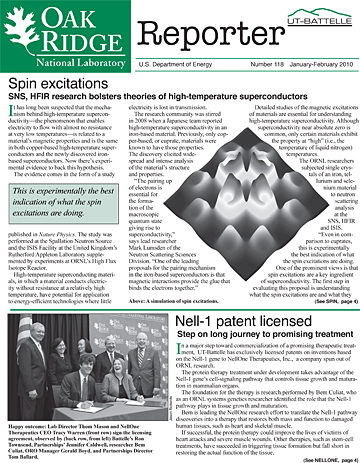

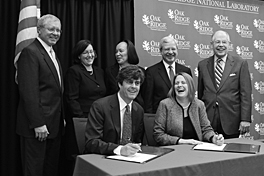






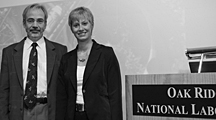







 Get the details and latest news on Club ORNL Events online via the ORNL home page and on ORNL Today. This information can also be viewed outside of ORNL via the external Club ORNL SharePoint Site: https://info.ornl.gov/sites/clubornl. From this site, you can view upcoming Club ORNL Events, and ORNL retirees can request an XCAMS account. Having an XCAMS account will allow ORNL retirees to participate in these events. Lara James is the retiree point of contact, 576-3753 or jamesla@ornl.
Get the details and latest news on Club ORNL Events online via the ORNL home page and on ORNL Today. This information can also be viewed outside of ORNL via the external Club ORNL SharePoint Site: https://info.ornl.gov/sites/clubornl. From this site, you can view upcoming Club ORNL Events, and ORNL retirees can request an XCAMS account. Having an XCAMS account will allow ORNL retirees to participate in these events. Lara James is the retiree point of contact, 576-3753 or jamesla@ornl.